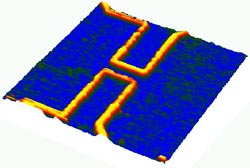A Mesoscopic Mystery

Researchers continue to push rival interpretations of a vexing problem in mesoscopic physics, the size scale where quantum and classical worlds co-exist. The conductance across a narrow bridge between two reservoirs of electrons–a so-called quantum point contact–was expected to follow simple quantum rules, but doesn’t. A group publishing in the 9 December print issue of PRL proposes a model of automatic electron spin alignment to explain the conductance anomaly. But in the 4 November print issue, another group’s theory supports the claim that physics concepts borrowed from the world of material impurities is key. Both teams hope they’re approaching a resolution to a problem that has turned mesoscopic physics on its head.
Researchers had thought that a quantum point contact (QPC) was essentially a “particle in a box,” whose properties are the stuff of sophomore physics classes. The conductance between the two electron reservoirs increases in a stepwise fashion as the width of the connecting channel is increased, paralleling the ground and excited states of an atom. “Everyone thought, ‘My gosh, what could be simpler than that?’” says Ned Wingreen of the NEC Laboratories America, Inc., in Princeton. Then in 1996 researchers saw an additional step where it shouldn’t be if the system were truly operating by simple rules. The so-called 0.7 anomaly, named for its conductance value in units of fundamental constants, means “what we thought is best understood in mesoscopic physics is least understood,” says Wingreen.
Most attempts to crack the problem have revolved around electron spin, which comes in two values, up and down. When a magnetic field is applied to the QPC, the conductance levels “split”–new steps appear between the old ones–because the magnetic field affects electrons differently depending on their spin. The 0.7 step remains even at zero magnetic field, so researchers have proposed that interactions among the electrons could be producing an intrinsic magnetic field that spontaneously aligns spins and causes some splitting.
Now David Reilly of the University of New South Wales in Sydney and his colleagues say their measurements support a simple model of spin alignment that fits the myriad 0.7 data. They studied how the conductance in a point contact changes as the density of electrons in the reservoirs and connecting channel is increased. At low densities the system looks like it does without a magnetic field, but as the density grows and electron interactions increase, the conductance pattern matches that observed under a strong magnetic field, even without any field being applied. “Our model is consistent with key data from the last ten years,” says Reilly, although it doesn’t yet include a complete microscopic theory.
More recent data have made some physicists take a second look. Wingreen and coauthors of the other PRL paper offer theoretical backing for a proposal [1] that the anomaly is caused by something like the Kondo effect, first observed in metals doped with impurities. In the classic Kondo effect, a lower than expected conductance can appear when electrons scatter off a magnetic impurity atom with an unpaired electron. In the QPC, single electrons crossing the channel temporarily pause in the middle and act like the unpaired electron of the classic effect. In both cases the electrons’ spins interact and lead to a change in conductance, though in the QPC the conductance goes up. Wingreen says the Kondo-like explanation has the virtue of building on known physics principles; those promoting spin polarization are actually seeing a Kondo-like effect and not realizing it, he believes.
Reilly thinks the two different physical explanations may be compatible, applying to different temperature regimes and experimental set-ups. But Charles Marcus of Harvard University, coauthor of the earlier Kondo paper, says the two views are fundamentally at odds. Kondo-like systems have fluctuating spins at low temperature, whereas spin alignment requires the spins to freeze in a preferred orientation. Why data such as Reilly et al.’s would not show Kondo-esque signs is mysterious and needs sorting out, he says.
–JR Minkel
JR Minkel is a freelance science writer in New York City.
References
- S. M. Cronenwett et al., Phys. Rev. Lett. 88, 226805 (2002)
More Information
R. Fitzgerald, Physics Today May 2002, page 21 (requires subscription)


